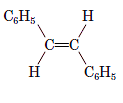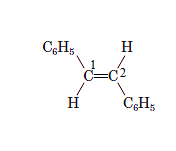
Concept explainers
(a)
Interpretation:The name of the following compound should be determined:

Concept Introduction: International Union of Pure and Applied Chemistry (IUPAC) recommended a nomenclature method used for naming organic chemical compounds.
(a)
Answer to Problem 59P
1-chloro-4-nitrobenzene.
Explanation of Solution
For the given organic compound, the number of substituents present on benzene ring is two and no substituent in the compound imparts special name. So, the numbering is done according to alphabetical order:

The name of the substituent at position 1 is chloro and at position 4 is nitro. So, the name of the compound is 1-chloro-4-nitrobenzene.
(b)
Interpretation: The name of the following compound should be determined:

Concept Introduction: International Union of Pure and Applied Chemistry (IUPAC) recommended a nomenclature method used for naming organic chemical compounds.
(b)
Answer to Problem 59P
2-bromotoluene.
Explanation of Solution
For the given organic compound, the number of substituents present on benzene ring is two and due to presence of methyl group its parent molecule is -toluene. The numbering for rest substituent is done as shown:

The name of the substituent is -bromo and is present at position 2 so, the name of the compound is 2-bromotoluene.
(c)
Interpretation: The name of the following compound should be determined:
Concept Introduction: International Union of Pure and Applied Chemistry (IUPAC) recommended a nomenclature method used for naming organic chemical compounds.
(c)
Answer to Problem 59P
1-chloro-3-phenylpropane.
Explanation of Solution
In
The substituent at position 1 is chloro so, the name of the compound is 1-chloro-3-phenylpropane.
(d)
Interpretation: The name of the following compound should be determined:

Concept Introduction: International Union of Pure and Applied Chemistry (IUPAC) recommended a nomenclature method used for naming organic chemical compounds.
(d)
Answer to Problem 59P
2-bromo-2-phenylbutane.
Explanation of Solution
In the given compound,

The substituent at position 2 is bromo so, the name of the compound is 2-bromo-2-phenylbutane.
(e)
Interpretation: The name of the following compound should be determined:

Concept Introduction: International Union of Pure and Applied Chemistry (IUPAC) recommended a nomenclature method used for naming organic chemical compounds.
(e)
Answer to Problem 59P
2-nitroaniline.
Explanation of Solution
For the given organic compound, the number of substituents present on benzene ring is two and due to presence of

The name of the substituent is -nitro present at position 2 so, the name of the compound is 2-nitroaniline.
(f)
Interpretation: The name of the following compound should be determined:

Concept Introduction: International Union of Pure and Applied Chemistry (IUPAC) recommended a nomenclature method used for naming organic chemical compounds.
(f)
Answer to Problem 59P
2-phenylphenol.
Explanation of Solution
For the given organic compound, the number of substituents present on benzene ring is two and due to presence of hydroxyl group its parent molecule is -phenol. The numbering for the substituent is done as shown:

The name of the substituent is -phenyl present at position 2 so, the name of the compound is 2-phenylphenol.
(g)
Interpretation: The name of the following compound should be determined:

Concept Introduction: International Union of Pure and Applied Chemistry (IUPAC) recommended a nomenclature method used for naming organic chemical compounds.
(g)
Answer to Problem 59P
trans -1,2-diphenylethene.
Explanation of Solution
In the given compound,

The phenyl substituents are present at opposite sides of the double bond so, the name of the compound istrans -1,2-Diphenylethene
(h)
Interpretation: The name of the following compound should be determined:

Concept Introduction: International Union of Pure and Applied Chemistry (IUPAC) recommended a nomenclature method used for naming organic chemical compounds.
(h)
Answer to Problem 59P
2,4-dichlorotoluene.
Explanation of Solution
For the given organic compound, the number of substituents present on benzene ring are three and due to presence of methyl group its parent molecule is -toluene. The numbering for the substituent is done as shown:

The name of the substituent is -chloro present at position 2 and 4 so, the name of the compound is 2,4-dichlorotoluene.
Want to see more full solutions like this?
Chapter 12 Solutions
Introduction to General, Organic and Biochemistry
- > Can the molecule on the right-hand side of this organic reaction be made in good yield from no more than two reactants, in one step, by moderately heating the reactants? esc ? A O O •If your answer is yes, then draw the reactant or reactants in the drawing area below. You can draw the reactants in any arrangement you like. • If your answer is no, check the box under the drawing area instead. olo 18 Ar Explanation Check BB Click and drag to start drawing a structure. 2025 McGraw Hill LLC. All Rights Reserved. Terms of Use | Privacy Center Accessibilityarrow_forwardName the structurearrow_forward> For each pair of substrates below, choose the one that will react faster in a substitution reaction, assuming that: 1. the rate of substitution doesn't depend on nucleophile concentration and 2. the products are a roughly 50/50 mixture of enantiomers. Substrate A Substrate B Faster Rate X CI (Choose one) (Choose one) CI Br Explanation Check Br (Choose one) C 2025 McGraw Hill LLC. All Rights Reserved. Terms of Use | Privacy A F10arrow_forward
- How to draw this mechanism for the foloowing reaction in the foto. thank youarrow_forwardPredict the major products of the following organic reaction: Some important notes: CN A? • Draw the major product, or products, of the reaction in the drawing area below. • If there aren't any products, because no reaction will take place, check the box below the drawing area instead. • Be sure to use wedge and dash bonds when necessary, for example to distinguish between major products that are enantiomers. No reaction. Explanation Check Click and drag to start drawing a structure. 2025 McGraw Hill LLC. All Rights Reserved. Terms of Use Privacy Centerarrow_forwardDraw the major product of the following reaction. Do not draw inorganic byproducts. H3PO4 OHarrow_forward
- Predict the major products of this organic reaction: HBr (1 equiv) Δ ? Some important notes: • Draw the major product, or products, of this reaction in the drawing area below. • You can draw the products in any arrangement you like. • Pay careful attention to the reaction conditions, and only include the major products. • Be sure to use wedge and dash bonds when necessary, for example to distinguish between major products that are enantiomers. • Note that there is only 1 equivalent of HBr reactant, so you need not consider the case of multiple additions. Explanation Check X ©2025 McGraw Hill LLC. All Rights Reserved. Terms of Use | Privacyarrow_forwardFor the structure below, draw the resonance structure that is indicated by the curved arrow(s). Be sure to include formal charges. :ÖH Modify the second structure given to draw the new resonance structure. Include lone pairs and charges in your structure. Use the + and - tools to add/remove charges to an atom, and use the single bond tool to add/remove double bonds.arrow_forwardUsing the table of Reactants and Products provided in the Hints section, provide the major product (with the correct stereochemistry when applicable) for questions below by selecting the letter that corresponds to the exact chemical structures for the possible product. OH conc Hydrochloric acid 40°C Temp A/arrow_forward
- Using arrows to designate the flow of electrons, complete the reaction below and provide a detailed mechanism for the formation of the product OH conc Hydrochloric acid 40°C Temp All chemical structures should be hand drawn on a piece of paper Paragraph BI UAE +varrow_forwarddraw out the following structures plesearrow_forwardDraw everything on a piece of paper outlining the synthesis from acetaldehyde to 2 cyclopentene carboxaldehyde using carbon based reagants with 3 carbons or fewers. Here is the attached image.arrow_forward
 Living By Chemistry: First Edition TextbookChemistryISBN:9781559539418Author:Angelica StacyPublisher:MAC HIGHER
Living By Chemistry: First Edition TextbookChemistryISBN:9781559539418Author:Angelica StacyPublisher:MAC HIGHER Chemistry for Engineering StudentsChemistryISBN:9781337398909Author:Lawrence S. Brown, Tom HolmePublisher:Cengage Learning
Chemistry for Engineering StudentsChemistryISBN:9781337398909Author:Lawrence S. Brown, Tom HolmePublisher:Cengage Learning World of Chemistry, 3rd editionChemistryISBN:9781133109655Author:Steven S. Zumdahl, Susan L. Zumdahl, Donald J. DeCostePublisher:Brooks / Cole / Cengage Learning
World of Chemistry, 3rd editionChemistryISBN:9781133109655Author:Steven S. Zumdahl, Susan L. Zumdahl, Donald J. DeCostePublisher:Brooks / Cole / Cengage Learning Introductory Chemistry: An Active Learning Approa...ChemistryISBN:9781305079250Author:Mark S. Cracolice, Ed PetersPublisher:Cengage Learning
Introductory Chemistry: An Active Learning Approa...ChemistryISBN:9781305079250Author:Mark S. Cracolice, Ed PetersPublisher:Cengage Learning Introductory Chemistry: A FoundationChemistryISBN:9781337399425Author:Steven S. Zumdahl, Donald J. DeCostePublisher:Cengage Learning
Introductory Chemistry: A FoundationChemistryISBN:9781337399425Author:Steven S. Zumdahl, Donald J. DeCostePublisher:Cengage Learning





